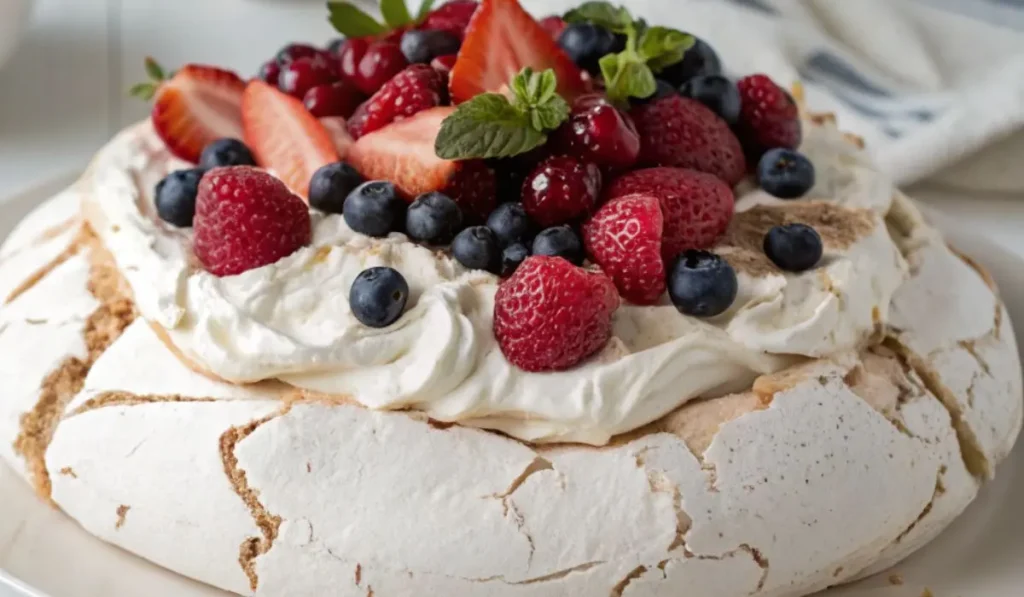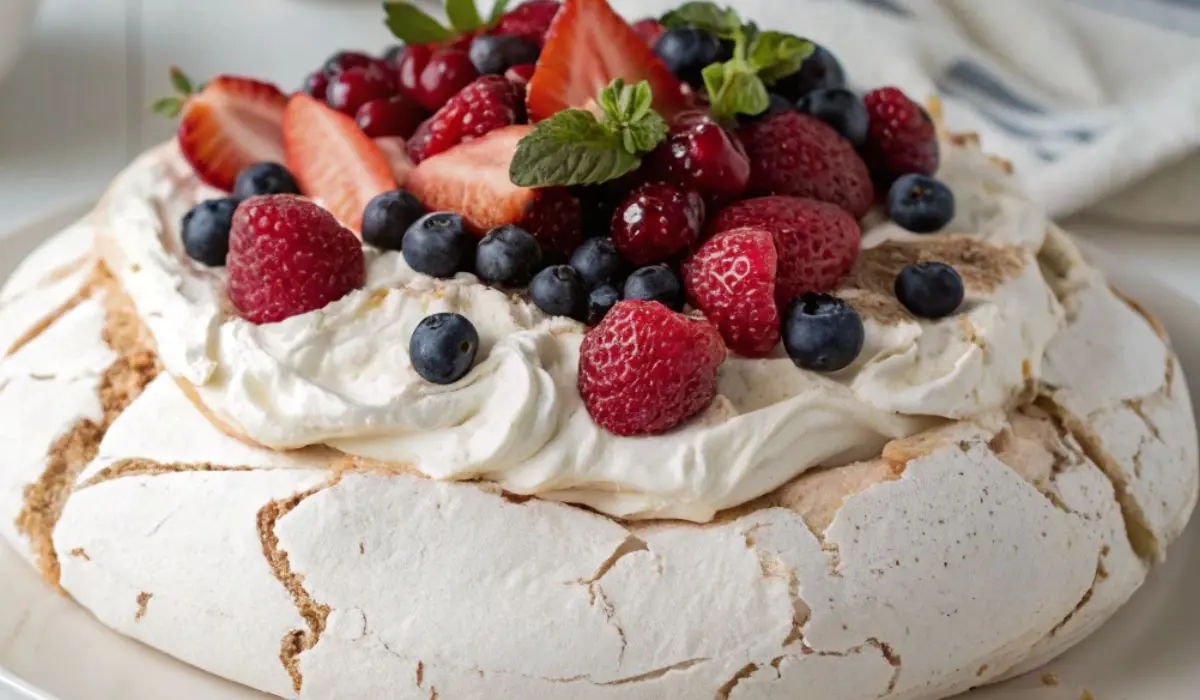This classic pavlova recipe creates the perfect Australian meringue dessert with a crispy shell and marshmallow-soft center. After making dozens of pavlovas over the years, I’ve learned the exact techniques that guarantee success every time.
Pavlova is Australia’s beloved summer dessert. The combination of light meringue, fluffy cream, and fresh fruit creates an unforgettable treat. Many home bakers avoid making pavlova because they think it’s too difficult. The truth is, with the right method, anyone can master this stunning dessert.

Essential Pavlova Ingredients
The beauty of homemade pavlova lies in its simple ingredient list. Each component plays a crucial role in creating the perfect texture and stability.
For the Meringue Base:
- 150ml (5 oz) egg whites from 4-5 fresh eggs
- 1 cup superfine sugar (caster sugar)
- 1 tablespoon cornstarch, sifted
- 1 teaspoon white vinegar
For the Cream Topping:
- 1½ cups heavy cream
- ¼ cup superfine sugar
- 1 teaspoon vanilla extract
Fresh Fruit Options:
- Strawberries, raspberries, blueberries
- Kiwi fruit, passion fruit pulp
- Cherries or any seasonal berries
The cornstarch and vinegar work together to stabilize the meringue. This combination prevents collapse and creates that signature chewy center that makes pavlova special.
Step-by-Step Pavlova Instructions
Creating the perfect meringue pavlova requires attention to detail and proper timing. Follow these proven steps for guaranteed success.
Preparation Phase:
- Separate egg whites while eggs are cold (much easier this way)
- Measure exactly 150ml of egg whites for consistency
- Let egg whites reach room temperature for better volume
- Preheat oven to 340°F (170°C)
Making the Meringue:
- Beat egg whites until soft peaks form using a stand mixer
- Add sugar one tablespoon at a time while beating continuously
- Beat for 3 more minutes until thick and glossy
- Test by rubbing mixture between fingers – no sugar grit should remain
- Gently fold in cornstarch and vinegar for 5-7 seconds
Shaping Your Pavlova:
- Turn a 9-inch springform pan base upside down
- Place parchment paper on top, securing with small dabs of meringue
- Spoon half the meringue onto paper, creating an 8-inch circle
- Add remaining meringue, shaping into a dome with sloping edges
- Keep height to 2 inches maximum for stability
Expert Baking Tips for Success
My years of pavlova making have taught me these critical techniques that prevent common failures.
Temperature Control:
- Start at high heat, then immediately reduce to 240°F (115°C)
- This initial blast creates the crispy outer shell quickly
- Lower temperature prevents browning and ensures stability
Timing and Patience:
- Bake for 1½ hours without opening the oven door
- Turn off oven and leave pavlova inside overnight
- Gradual cooling prevents cracking and maintains structure
Weather Considerations:
Hot, humid weather challenges pavlova success. On humid days, stick to smaller pavlovas and avoid making them too tall. The moisture in the air can cause collapse during baking.
Common Pavlova Problems and Solutions
Even experienced bakers encounter pavlova challenges. Here’s how to handle the most frequent issues.
Cracking Prevention:
- Use fresh (not old) store-bought eggs
- Ensure bowls and utensils are completely clean and grease-free
- Don’t overbeat the meringue after adding cornstarch
- Avoid opening the oven door during baking
Collapse Solutions:
If your pavlova cracks or collapses, don’t panic. Use whipped cream as “glue” to piece it back together. Once topped with cream and fruit, even a severely cracked pavlova looks beautiful and tastes amazing.
Serving and Storage Tips
Proper handling ensures your pavlova looks as good as it tastes when served.
Assembly Guidelines:
- Top with cream just before serving
- Arrange fruit gently by hand, not by dumping from a bowl
- Serve within 30 minutes of adding toppings for best texture
Storage Method:
Store the cooled, untopped pavlova in an airtight container at room temperature. Never refrigerate the bare meringue as it will absorb moisture and lose its crispy shell. The pavlova base keeps for up to 24 hours this way.
Why This Pavlova Recipe Works
This Australian pavlova recipe succeeds because it addresses the main causes of failure. The measured egg whites ensure consistency. The gradual temperature reduction creates stability. The overnight cooling prevents thermal shock cracking.
I’ve served this recipe to hundreds of guests over the years, and it never fails to impress. The contrast between the crispy meringue exterior and soft marshmallow interior, combined with fresh cream and seasonal fruit, creates the ultimate summer dessert experience.
Whether you’re making pavlova for Christmas dinner, a summer barbecue, or any special occasion, this foolproof method delivers restaurant-quality results every time. The key is following the techniques exactly and being patient with the cooling process.

Perfect Pavlova
Ingredients
Equipment
Method
- Separate egg whites while eggs are cold, then measure exactly 150ml. Let whites come to room temperature for 30 minutes. Preheat oven to 340°F (170°C).
- Using a stand mixer, beat egg whites on medium-high speed until soft peaks form. This takes about 3-4 minutes.
- Add superfine sugar one tablespoon at a time while beating continuously. After all sugar is added, beat for 3 more minutes until thick and glossy. Test by rubbing mixture between fingers – no sugar grit should remain.
- Gently fold in cornstarch and vinegar using a spatula for just 5-7 seconds until barely combined.
- Turn a 9-inch springform pan base upside down and place parchment paper on top, securing with small dabs of meringue at edges.
- Spoon half the meringue onto paper, creating an 8-inch circle. Add remaining meringue and shape into a dome with gently sloping edges, keeping height to 2 inches maximum.
- Place in oven and immediately reduce temperature to 240°F (115°C). Bake for 1½ hours without opening the oven door.
- Turn off oven and leave pavlova inside with door closed to cool completely overnight or for at least 8 hours.
- For topping: Beat heavy cream, sugar, and vanilla until soft peaks form. Don’t overbeat.
- Carefully transfer pavlova to serving platter. Top with whipped cream and arrange fresh fruit gently by hand just before serving.
